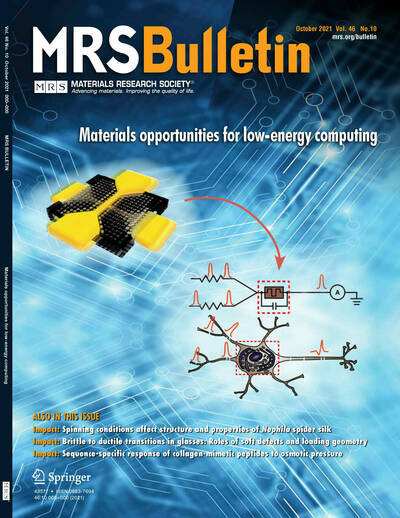
Subhash L. Shinde, associate director of the Center for Sustainable Energy (ND Energy) at the University of Notre Dame and member of MRS Bulletin Editorial Board, served as the invited guest editor of the bulletin’s latest issue, Volume 46, Issue 10, October 2021, which focuses on Materials Opportunities for Low-Energy Computing. Shinde brought in two other leading experts, Prof. Asif Khan from Georgia Institute of Technology and Dr. Hui Jae Yoo from Intel, to serve as co-editors and to aid in the comprehensive review and approval process.
“With the explosion of data and processing required to turn that data into useful information, there is an unprecedented need for energy-efficient computation,” said Shinde. “In the last decade, the rate at which data was generated outpaced improvements in compute efficiency, leading to high energy consumption.”
For perspective, data centers consume over 200 terawatt hours each year, which exceeds the total energy consumption of some countries. As a comparison, a human brain typically consumes 25 watts and about 10 watts out of that for ‘useful’ computation. Although there has been a collective effort among academia, industry, and government to explore multi-faceted approaches for advancing low energy computing, energy use for computing remains an increasing concern.
“The benefits of energy efficiency go beyond extending battery lifetimes for compute devices that are at the very ‘edge’ of computational networks, such as cell phones, a computer in an autonomous car, or reducing data center energy costs,” said Yoo. “Large scale integration of devices and memory needed in artificial intelligence and cloud computing requires an intrinsic reduction in the energy per bit.”
Today’s computing systems are highly complex. Starting at the smallest scale, there are switching elements that comprise logic and/or memory. These elements are put together at the package level with passives, thermal management solutions, and interconnects to form the integrated chip. Materials touch every one of these components.
“The extreme need for energy efficiency in the next generation computation calls for a bottom-up approach, innovating at the lowest level of the computing hierarchy—the material and device level—to deliver the required functionalities beyond what is available with current complementary metal-oxide semiconductor (CMOS) platforms,” said Khan. “Such innovations can then be leveraged at the circuit, micro-architecture, system and (microelectronic) package and software levels to deliver autonomy by energy-efficient computing, logic–memory co-location, and performance gain, while improving (compute) performance per watt.”
Shinde continued, “Since there is already a substantial body of knowledge in this field spanning multiple approaches, co-editors Khan, Yoo and I decided to focus this MRS Bulletin special issue specifically on the materials challenges and opportunities that will accelerate solutions for energy-efficient computation.”
These areas are described below with links to the articles for easy access and viewing.
-
Materials opportunities for low-energy computing
Asif Khan, Hui Jae Yoo, Subhash L. Shinde & Prasanna Venkat Ravindran -
Ferroelectric gate oxides for negative capacitance transistors
Michael Hoffmann & Sayeef Salahuddin -
Magnetoelectrics and multiferroics: Materials and opportunities for energy-efficient spin-based memory and logic
John T. Heron & Tony Chiang -
Overview and outlook of emerging non-volatile memories
Mengwei Si, Huai-Yu Cheng, Takashi Ando, Guohan Hu & Peide D. Ye -
Materials for interconnects
Daniel Gall, Judy J. Cha, Zhihong Chen, Hyeuk-Jin Han, Christopher Hinkle, Joshua A. Robinson, Ravishankar Sundararaman & Riccardo Torsi -
Materials for heterogeneous integration
Madhavan Swaminathan, Mohan Kathaperumal, Kyoung-sik Moon, Himani Sharma, Prahalad Murali & Siddharth Ravichandran -
Materials challenges and opportunities for brain-inspired computing
Y. D. Zhao, J. F. Kang & D. Ielmini
About MRS Bulletin
MRS Bulletin is one of the most widely recognized and highly respected publications in advanced materials research. Each month, MRS Bulletin provides a comprehensive overview of a specific materials theme topic with related articles written by leading experts.
About ND Energy
ND Energy is a University Center whose mission is to build a better world by creating new energy technologies and systems and educating individuals to help solve the most critical energy challenges facing the world today. For more information, please visit the ND Energy website at energy.nd.edu or contact Barbara Villarosa, Business and Communications Program Director, at bvillaro@nd.edu or 574-631-4776.